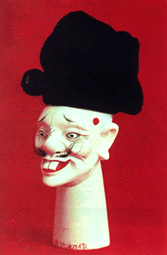In its prime, Chaozhou wire puppetry boasted nearly 100 troupes, the best known being the Yuanxiang one. In addition, Chaozhou was home to three small puppet theaters, namely the Wanli, Wanxing, and Guanghui theaters. The most famous puppeteers included Xie Baoquan, Xie Xianglin, Aliang, Wu Binquan, Cai Jingkun, Lu Jilin, and Lin Yaoxiang. The themes of the plays mostly focused on history, novels, and myths.
The programs, which were more or less like those of Chaozhou Opera, included well-known items such as The Trial of Guo Huai, Xue Rengui Leads an Expedition Against the East, Lord Bao Meets Empress Dowager Li, The Red Boy, and The Story of the Straw Sandals. Acrobatic stunts such as juggling weapons, wielding cudgels, balancing pots on the head, and spinning plates were often performed to enliven the stage atmosphere.
One of the best wire puppet troupes in Chaozhou, the Yuanxiang, took part in the First National Puppet Show and Shadow Play Festival held inBeijingin 1955, where it received warm acclaim for its excellent performances and colorful Chaozhou singing Today, wire puppet troupes are still active in the countryside, particularly during festivals.
 Glove Puppet Shows in Longxi, Fujian
Glove Puppet Shows in Longxi, Fujian
 Glove puppets in Longxi are also known as palm puppets. According to Records ofZhangzhouPrefecture, puppet shows appeared in Longxi during the Song Dynasty. Glove puppets flourished after the middle of the Qing Dynasty and before the War of Resistance Against Japan (World War II) in 1937. Around that time, almost every township in Longxi, Zhangpu, Haicheng, and Changtai counties in Fujian had a professional or amateur puppet troupe, and puppetry had become part of the spiritual life of the people in those areas.
Glove puppets in Longxi are also known as palm puppets. According to Records ofZhangzhouPrefecture, puppet shows appeared in Longxi during the Song Dynasty. Glove puppets flourished after the middle of the Qing Dynasty and before the War of Resistance Against Japan (World War II) in 1937. Around that time, almost every township in Longxi, Zhangpu, Haicheng, and Changtai counties in Fujian had a professional or amateur puppet troupe, and puppetry had become part of the spiritual life of the people in those areas.
The glove puppet is manipulated with fingers. Because it is capable of forceful and rapid movements, it is most suitable for battle scenes. The main feature of glove puppets is their heads. The noted puppet carver Xu Zhuchu and his son carefully studied the types of roles in Chinese opera and their facial masks and produced many fine puppet heads that represented all types of people -- the loyal and the treacherous, the good and the evil.
The performance level of a puppeteer depends on his finger dexterity. Good puppeteers make full use of an assortment of their puppet's postures to portray their character's inner feelings. Hard training and practice enables puppeteers to rotate their hand inside the glove or to rapidly and unerringly transfer the puppet from one hand to the other without being noticed.
